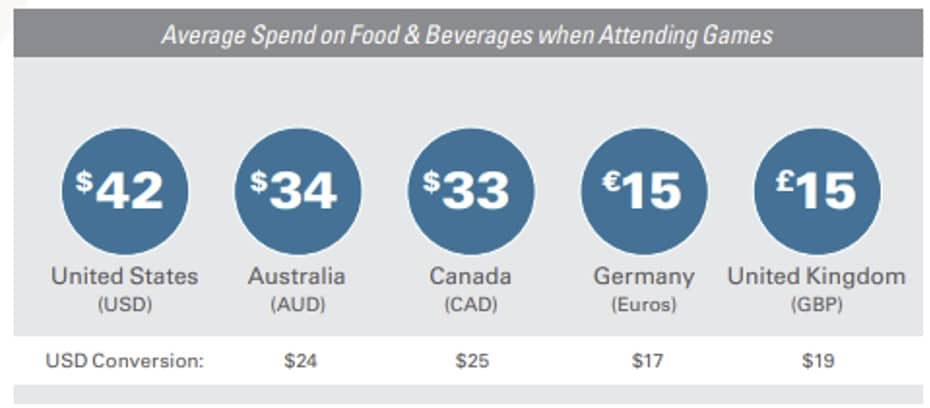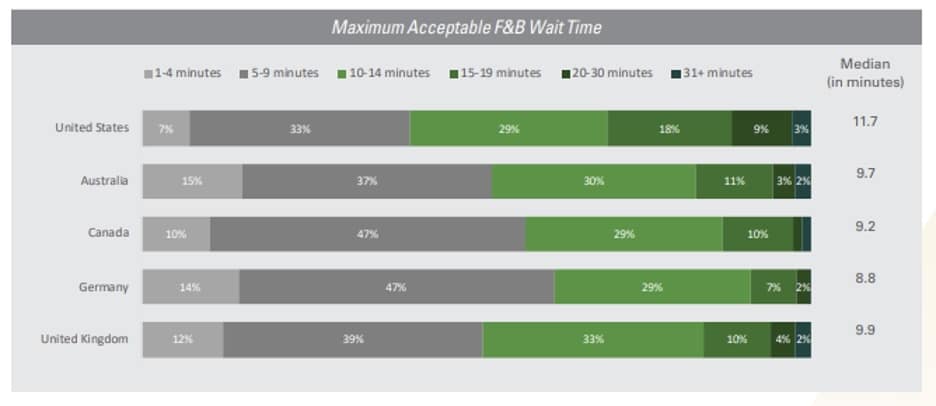Nowadays, with live events, the hospitality sector stands at a crucial juncture. Attendees’ expectations are soaring. These are driven by a desire for seamless experiences, quicker service, and more personalised interactions.
However, a gap remains between these expectations and the reality of long queues, limited food and beverage options, and a one-size-fits-all approach to customer service. This discrepancy affects guest satisfaction and represents a missed opportunity for increased revenue.
A notable study by Oracle Food and Beverage underscores this challenge. This study revealed that while 94% of attendees purchase food and beverages at events, 58% are deterred by the prospect of waiting in lines.
Obviously, this is a huge problem for live events. However, what if there were new emerging live event technology trends that:
The BRISK Solution introduces a groundbreaking approach to streamline beverage service at stadiums and festivals. Utilising self-service Point-of-Sale (POS) terminals, this system allows attendees to bypass traditional queues.
With a simplified selection of best-selling drinks, customers can tap their card at an entry turnstile, select their beverage, and exit swiftly. This method accelerates the service process and aligns with the dynamic needs of high-volume events.
Long wait times and the limited capacity of staff to manage peak demand periods significantly impact customer satisfaction and sales at live events. This challenge is particularly acute in regions such as the UK and Europe, where the average spend on food and beverages is notably low:
 Source: Oracle Food and Beverage
Source: Oracle Food and Beverage
The introduction of The BRISK Solution at live events aims to tackle these challenges head-on. Facilitating quicker access to beverages and reducing the need for extensive staffing and lower wait times. These lower wait times, in turn, turn into more sales:
 Source: Oracle Food and Beverage
Source: Oracle Food and Beverage
The model itself is designed to be quick, reliable, and adaptable, making it perfectly suited for the environment of live events.
Computer vision technology is set to revolutionise live event experiences, offering a secure and innovative way to profile attendees, streamline age verification processes, and estimate venue busyness.
By analysing visual data in real time, this technology provides insights that enhance safety, customer service, and venue operations. Its adaptability allows for integration into various platforms, from self-service kiosks to advanced solutions like The BRISK Solution, making it a flexible and forward-thinking addition to event management.
Events targeting a younger audience, such as music festivals, often encounter challenges with age verification due to regulations like Challenge 25, which mandates thorough checks for anyone who appears under 25.
This can lead to increased queue times and a less-than-optimal attendee experience. Additionally, managing large crowds efficiently while ensuring a safe environment remains a significant concern, with traditional methods often lacking in providing timely and accurate data.
Using computer vision technology at live events can dramatically improve these aspects. For age verification, it offers a fast, accurate, and reliable method, reducing queues and enhancing the overall attendee experience. Regarding crowd management, computer vision enables real-time busyness estimation, helping organisers adapt and manage the flow of attendees more effectively.
The retail sector is an illustrative example of computer vision’s potential, where stores utilise this technology to create heat maps. These heatmaps analyse customer movement and density, informing store layout and design decisions to optimise conversions. Similarly, computer vision could provide invaluable insights into attendee flow and behaviour at live events, enabling organisers to design safer and more engaging event spaces.
Live event technology has evolved, bringing a pivotal shift from conventional dashboards to using data science-driven insights. This transition marks a move towards a more refined, actionable, and context-rich understanding of data.
Traditional dashboards, while useful, often fall short in delivering the depth of information necessary for effective upselling, analysing selling data, and optimising the overall venue experience. Data science and advanced analytics promise a new horizon, offering a clear pathway to enhance venue experiences and maximise revenue.
Traditional dashboards have been a staple in event management for years, offering a bird’s-eye view of operations and customer interactions. However, their major downfall lies in their static nature and lack of contextual depth.
These dashboards typically present data without the nuances of why certain trends occur or how different factors interplay to affect outcomes. This limitation hinders the ability to make strategic decisions that could impact revenue generation and the overall attendee experience.
Through the lens of data science, event organisers can access actionable insights that delve into the specifics of best-selling products, the timing of sales peaks, and customer purchasing patterns.
For instance, AI can analyse vast amounts of data to predict which items are likely to sell more on specific days or times and what complementary products customers might be interested in. This level of analysis enhances operational strategies and personalises the venue experience, leading to higher customer satisfaction and loyalty.
Moreover, applying data science helps to maximise revenue through targeted upselling. By identifying patterns and preferences, AI-driven systems can recommend the most effective upsell opportunities at the right times, thereby boosting sales without compromising the customer experience.
Recommender systems stand at the forefront of emerging live event technology, offering a tailored approach to enhancing the guest experience. Through sophisticated algorithms, these systems analyse past purchasing behaviours at terminals, kiosks, or mobile apps to provide personalised recommendations.
This innovative application of technology ensures that each suggestion is specifically aligned with the guest’s preferences, elevating the event experience to new heights of personalisation and engagement.
Traditional event experiences often suffer from a one-size-fits-all approach, where the vast diversity of guest preferences is overlooked. This not only leads to generic customer experiences but also misses crucial opportunities for targeted upselling and efficient inventory management.
Without the insights provided by recommender systems, event organisers are left to navigate the complexities of customer satisfaction and stock rotation through guesswork, potentially leading to unsold inventory and unmet guest desires.
Integrating recommender systems into the event technology ecosystem addresses these challenges head-on. By offering personalised suggestions, these systems significantly enhance guest satisfaction, creating a more engaging and memorable experience.
Moreover, the precise targeting facilitated by these recommendations can substantially increase sales through effective upselling, directly contributing to the event’s financial success. Additionally, the data-driven nature of recommender systems allows for more accurate inventory management, ensuring that popular items are well-stocked and reducing the risk of overstocking less popular products.
Integrating Large Language Models (LLMs) into venue management marks a significant leap forward in harnessing AI for actionable insights. Unlike traditional data analysis tools that often present findings in complex graphs and charts, LLMs utilise generative AI to provide natural language insights.
This approach simplifies the interpretation of data, making it accessible and understandable for venue managers. For example, instead of deciphering a graph to determine the sales performance of a particular type of lager, an LLM can directly inform managers that a specific lager sells more on certain days, suggesting the introduction of targeted deals to boost sales.
Event management encompasses many complex tasks, from scheduling and logistics to customer service and sales optimisation. One of the most daunting challenges within this domain is the ability to make quick, data-driven decisions without extensive technical expertise.
Traditional data analysis methods often require a steep learning curve and can be time-consuming, limiting the ability of venue managers to respond to dynamic market conditions and attendee preferences efficiently.
LLMs offer a transformative solution by democratising data analysis through intuitive, natural language insights. This advanced technology simplifies the process of identifying trends, patterns, and opportunities within vast amounts of data, enabling venue managers to make informed decisions swiftly.
The benefits of employing LLMs in venue management are manifold. They enhance operational efficiency by providing straightforward recommendations for inventory management, promotional strategies, and customer engagement initiatives. Moreover, the use of LLMs contributes to a more dynamic and adaptable event experience, ensuring that venues can quickly adjust to changing attendee behaviours and market trends.
As we explore the horizon of live event technology, the transformative potential of the innovations discussed is undeniable. From the intuitive simplicity of self-service solutions like The BRISK Solution to the dynamic insights offered by data science and Large Language Models (LLMs), each emerging trend represents a leap forward in creating more secure, high-quality, and engaging event experiences.
The integration of cutting-edge technologies, such as computer vision solutions and personalised recommender systems, illustrates a shift towards a more personalised, efficient, and data-driven approach to event management. These advancements promise to enhance the attendee experience and streamline operations, ensuring events are both memorable and manageable.
The application of LLMs for natural language insights and the use of advanced analytics to drive decision-making underscore a move towards more intuitive and accessible tools for venue management. This shift is critical in an industry where rapid adaptation and responsiveness are key to success. By leveraging these technologies, event organisers can ensure their venues are not only welcoming and flexible but also robust and adaptable to the ever-changing demands of their audiences.